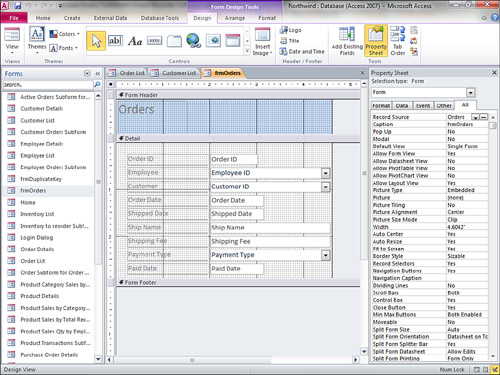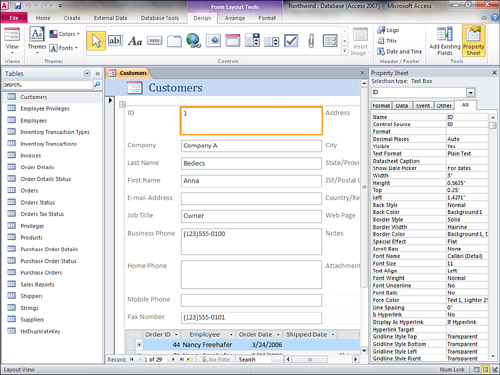1. Viewing the Design of a Form
You can use the View tool on the Ribbon to toggle back and forth between Design view and Form view. Figure 1
shows a form in Design view. When you are in Design view, you can
modify the underlying blueprint of the form. You can move and size
controls, and you can add and remove controls. In fact, you can change
the entire look, feel, and functionality of the form.

2. Closing a Form
To close a form, click the
close button (the X) in the upper-right corner of the form. If you try
to close a form without having made any design changes—that
is, changes that you make to the design of the form—Access does not
prompt you to save. This is because Access saves all data changes as you
move from row to row. If you close a form and save design changes,
those changes are permanent for all users of the form.
3. The AutoForm Feature
You
can quickly build forms by using the AutoForm feature. The AutoForm
feature gives you absolutely no control over how a form appears, but it
provides you with an instantaneous means of data entry.
Create a Form by Using the AutoForm Feature
Creating a form by using the AutoForm feature is amazingly easy. Here’s how it works:
1. | Select the table or query on which you want to base the new form. Select the Customers table for this example.
|
2. | Select Form in the Forms group on the Create tab of the Ribbon. Access creates a form based on the selected table or query (see Figure 2).
|

Saving a Form
Although
Access automatically saves all the data changes that you make to a
form, it is up to you to save all the design changes that you make to
the form. As you work with the design of a form, you should periodically
click the Save tool on the QuickAccess toolbar to save changes. When
you close the form, Access prompts you to once again save your changes.
Here’s the process:
1. | Click the close button (the X). A dialog box appears, asking whether you want to save your changes.
|
2. | Click the Yes button.
|
3. | If you have not yet named the form, Access prompts you with the Save As dialog box, asking you to provide a name for the form.
|
4. | Enter a form name and click OK.
|
|
Naming standards suggest that you use the frm prefix to name every form.
|
|
The name of a form can be up to 64 characters and can contain text, numbers, and spaces.
|
Sub-datasheets are available within forms, just as they are in datasheets.